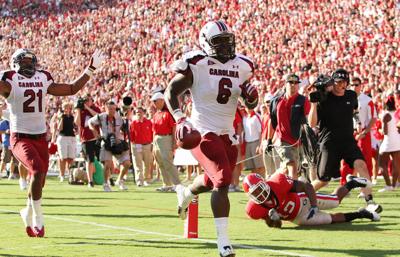The Medium Tank M7, initially Light Tank T7, was an American tank, originally conceived as an up-gunned replacement for the Light Tank M3/M5 ("Stuart"). The project developed to mount the same 75mm armament as the M4 Sherman while retaining the light weight and maneuverability of the M3 Stuart; however, during development the weight of the prototype surpassed the US Army's standard for light tanks and crossed into the medium tank category and was renamed.[1] The M7 had significantly less armor than the M4 Sherman, no greater firepower, and held only a slight advantage in top speed. For these reasons, and because the M4 was already battle-tested and in full production, the M7 was cancelled in 1943.

Gamecock Fanatics
You are using an out of date browser. It may not display this or other websites correctly.
You should upgrade or use an alternative browser.
You should upgrade or use an alternative browser.
Countdown to Kickoff II: The Final 24 Days
- Thread starter Swayin
- Start date
USS Wasp (CV-7) in Casco Bay, Maine, circa early 1942, with SB2U and F4F aircraft on her flight deck. Wasp is painted in a Measure 12 (Modified) camouflage pattern.

Wasp has always been a footnote in the story of the U. S. Navy in the Pacific in WW2 because she was not involved in any major battles before she was sunk, but her time in the Atlantic was important, too. This is going to be a multi-part post.
Wasp was the first carrier fitted with a deck-edge elevator.
A U.S. Navy Vought SB2U-2 Vindicator (BuNo 1376) from scouting squadron VS-72 pictured on the deck edge elevator of the aircraft carrier USS Wasp (CV-7) at Quincy, Massachusetts (USA), in June 1940. (below)



The elevator consisted of a platform for the front wheels and an outrigger for the tail wheel. The two arms on the sides moved the platform in a half-circle up and down between the flight deck and the hangar deck.

Stand by for Part 2...
https://en.wikipedia.org/wiki/USS_Wasp_(CV-7)USS Wasp (CV-7) was a United States Navy aircraft carrier commissioned in 1940 and lost in action in 1942. She was the eighth ship named USS Wasp, and the sole ship of a class built to use up the remaining tonnage allowed to the U.S. for aircraft carriers under the treaties of the time. As a reduced-size version of the Yorktown-class aircraft carrier hull, Wasp was more vulnerable than other United States aircraft carriers available at the opening of hostilities.
Wasp was initially employed in the Atlantic campaign, where Axis naval forces were perceived as less capable of inflicting decisive damage. After supporting the occupation of Iceland in 1941, Wasp joined the British Home Fleet in April 1942 and twice ferried British fighter aircraft to Malta.
Wasp was then transferred to the Pacific in June 1942 to replace losses at the battles of Coral Sea and Midway. After supporting the invasion of Guadalcanal, Wasp was hit by three torpedoes from Japanese submarine I-19 on 15 September 1942. The resulting damage set off several explosions, destroyed her water-mains and knocked out the ship's power. As a result, her damage-control teams were unable to contain the ensuing fires that blazed out of control. She was abandoned and scuttled by torpedoes fired from USS Lansdowne later that evening. Her wreck was found in early 2019.
Wasp has always been a footnote in the story of the U. S. Navy in the Pacific in WW2 because she was not involved in any major battles before she was sunk, but her time in the Atlantic was important, too. This is going to be a multi-part post.
Wasp was the first carrier fitted with a deck-edge elevator.
A U.S. Navy Vought SB2U-2 Vindicator (BuNo 1376) from scouting squadron VS-72 pictured on the deck edge elevator of the aircraft carrier USS Wasp (CV-7) at Quincy, Massachusetts (USA), in June 1940. (below)
The elevator consisted of a platform for the front wheels and an outrigger for the tail wheel. The two arms on the sides moved the platform in a half-circle up and down between the flight deck and the hangar deck.
P-40Bs aboard Wasp in October 1940. (below)Occupation of Iceland
Following her return to Norfolk on 13 July 1941, Wasp and her embarked air group conducted refresher training off the Virginia Capes. Meanwhile, the situation in the Atlantic had taken on a new complexion, with American participation in the Battle of the Atlantic only a matter of time, when the United States took another step toward involvement on the side of the British. To protect American security and to free British forces needed elsewhere, the United States made plans to occupy Iceland. Wasp played an important role in the move.
Late on the afternoon of 23 July, while the carrier lay alongside Pier 7, NOB Norfolk, 32 Army Air Forces (AAF) pilots reported on board "for temporary duty". At 06:30 the following day, Wasp's crew watched an interesting cargo come on board, hoisted on deck by the ship's cranes: 30 P-40Cs and three PT-17 trainers from the AAF 33rd Pursuit Squadron, 8th Air Group, Air Force Combat Command, home-based at Mitchel Field, New York. Three days later, four newspaper correspondents – including the noted journalist Fletcher Pratt — came on board.
The carrier had drawn the assignment of ferrying those vital army planes to Iceland because of a lack of British aircraft to cover the American landings. The American P-40s would provide the defensive fighter cover necessary to watch over the initial American occupying forces. Wasp slipped out to sea on 28 July, with the destroyers O'Brien and Walke as plane guards. The heavy cruiser Vincennes later joined the formation at sea.
Within a few days, Wasp's group joined the larger Task Force 16—consisting of the battleship Mississippi, the heavy cruisers Quincy and Wichita, five destroyers, the auxiliary Semmes, the attack transport American Legion, the stores ship Mizar, and the amphibious cargo ship Almaack. Those ships, too, were bound for Iceland with the first occupation troops embarked.
On the morning of 6 August, Wasp, Vincennes, Walke, and O'Brien parted company from Task Force 16 (TF 16). Soon thereafter, the carrier turned into the wind and commenced launching the planes from the 33rd Pursuit Squadron. As the P-40s and the trio of trainers droned on to Iceland, Wasp headed home for Norfolk, her three escorts in company. After another week at sea, the group arrived back at Norfolk on 14 August.

Stand by for Part 2...
Last edited by a moderator:
Homebrewcock
GCF Top Poster
Homebrewcock
GCF Top Poster
USS Wasp (CV-7) Part Two
Wasp put to sea again on 22 August 1941 for carrier qualifications and refresher landings off the Virginia capes.

LTJG David McCampbell earned his Carrier Qualification (CQ) on the Wasp in June 1940 while the ship was transiting to the Carribean and would become an LSO on the ship. Historians will note that McCampbell would eventually become the Navy's highest ranking ace in WW2.
Two days later, Rear Admiral H. Kent Hewitt, Commander Cruisers, Atlantic Fleet, shifted his flag from the light cruiser Savannah to Wasp while the ships lay anchored in Hampton Roads. Underway on the 25th, in company with Savannah and the destroyers Monssen and Kearny, the aircraft carrier conducted flight operations over the ensuing days. Scuttlebutt on board the carrier had her steaming out in search of the German heavy cruiser Admiral Hipper, which was reportedly roaming the western Atlantic in search of prey. Suspicions were confirmed for many on the 30th when the British battleship HMS Rodney was sighted some 20 nautical miles (37 km; 23 mi) away, on the same course as the Americans.
In any event, if they had been in search of a German raider, they did not make contact with her.
October had seen the incidents involving American and German warships multiplying on the high seas. Kearny was torpedoed on 17 October, Salinas on 28 October, and in the most tragic incident that autumn, Reuben James was torpedoed and sunk with heavy loss of life on 30 October. Meanwhile, in the Pacific, tension between the U.S. and Japan increased almost with each passing day.
Wasp slipped out to sea from Grassy Bay, Bermuda, on 3 December and rendezvoused with Wilson. While the destroyer operated as plane guard, Wasp's air group flew day and night refresher training missions. In addition, the two ships conducted gunnery drills before returning to Grassy Bay two days later, where she lay at anchor on 7 December 1941 during the Japanese attack on Pearl Harbor.
After departing Norfolk on 14 January 1942, Wasp headed north and touched at NS Argentia, Newfoundland, and Casco Bay, Maine. She sailed for the British Isles on 26 March 1942 with Task Force 39 under the command of Rear Admiral John W. Wilcox, Jr., aboard the battleship Washington. That force was to reinforce the Home Fleet of the Royal Navy.
Wasp anchored in Casco, ME, along with the battleships Washington and North Carolina and an unidentified destroyer in March 1942. (below)

While en route, Rear Admiral Wilcox was swept overboard from the battleship on the morning of 27 March 1942 and drowned. Although hampered by poor visibility conditions, four SB2U Vindicators from Wasp planes took part in the search, and one of them crashed while attempting to land aboard Wasp, killing its two-man crew. Wilcox's body was spotted an hour after he went overboard, face down in the raging seas, but it was not recovered due to the weather and the heavy seas.
Rear Admiral Robert C. Giffen, who flew his flag in the heavy cruiser Wichita, assumed command of TF 39. The American ships were met by a force based around the light cruiser HMS Edinburgh on 3 April.
Sailors on board HMS Edinburgh watch Wasp as the two ships meet at sea in April 1942. (below)

Those ships escorted them to Scapa Flow in the Orkney Islands. While there, a Gloster Gladiator flown by Captain Henry Fancourt of the Royal Navy made the first landing of the war by a British plane on an American aircraft carrier when it landed on Wasp.

Wasp put to sea again on 22 August 1941 for carrier qualifications and refresher landings off the Virginia capes.
LTJG David McCampbell earned his Carrier Qualification (CQ) on the Wasp in June 1940 while the ship was transiting to the Carribean and would become an LSO on the ship. Historians will note that McCampbell would eventually become the Navy's highest ranking ace in WW2.
Two days later, Rear Admiral H. Kent Hewitt, Commander Cruisers, Atlantic Fleet, shifted his flag from the light cruiser Savannah to Wasp while the ships lay anchored in Hampton Roads. Underway on the 25th, in company with Savannah and the destroyers Monssen and Kearny, the aircraft carrier conducted flight operations over the ensuing days. Scuttlebutt on board the carrier had her steaming out in search of the German heavy cruiser Admiral Hipper, which was reportedly roaming the western Atlantic in search of prey. Suspicions were confirmed for many on the 30th when the British battleship HMS Rodney was sighted some 20 nautical miles (37 km; 23 mi) away, on the same course as the Americans.
In any event, if they had been in search of a German raider, they did not make contact with her.
October had seen the incidents involving American and German warships multiplying on the high seas. Kearny was torpedoed on 17 October, Salinas on 28 October, and in the most tragic incident that autumn, Reuben James was torpedoed and sunk with heavy loss of life on 30 October. Meanwhile, in the Pacific, tension between the U.S. and Japan increased almost with each passing day.
Wasp slipped out to sea from Grassy Bay, Bermuda, on 3 December and rendezvoused with Wilson. While the destroyer operated as plane guard, Wasp's air group flew day and night refresher training missions. In addition, the two ships conducted gunnery drills before returning to Grassy Bay two days later, where she lay at anchor on 7 December 1941 during the Japanese attack on Pearl Harbor.
After departing Norfolk on 14 January 1942, Wasp headed north and touched at NS Argentia, Newfoundland, and Casco Bay, Maine. She sailed for the British Isles on 26 March 1942 with Task Force 39 under the command of Rear Admiral John W. Wilcox, Jr., aboard the battleship Washington. That force was to reinforce the Home Fleet of the Royal Navy.
Wasp anchored in Casco, ME, along with the battleships Washington and North Carolina and an unidentified destroyer in March 1942. (below)
While en route, Rear Admiral Wilcox was swept overboard from the battleship on the morning of 27 March 1942 and drowned. Although hampered by poor visibility conditions, four SB2U Vindicators from Wasp planes took part in the search, and one of them crashed while attempting to land aboard Wasp, killing its two-man crew. Wilcox's body was spotted an hour after he went overboard, face down in the raging seas, but it was not recovered due to the weather and the heavy seas.
Rear Admiral Robert C. Giffen, who flew his flag in the heavy cruiser Wichita, assumed command of TF 39. The American ships were met by a force based around the light cruiser HMS Edinburgh on 3 April.
Sailors on board HMS Edinburgh watch Wasp as the two ships meet at sea in April 1942. (below)
Those ships escorted them to Scapa Flow in the Orkney Islands. While there, a Gloster Gladiator flown by Captain Henry Fancourt of the Royal Navy made the first landing of the war by a British plane on an American aircraft carrier when it landed on Wasp.
Last edited by a moderator:
Homebrewcock
GCF Top Poster
USS Wasp (CV-7) Part Three
A trio of Royal Navy Fairey Swordfish torpedo bombers "coming in for the break" peeling off to get into the Wasp's landing pattern in April 1942. (below)

A Swordfish "in the groove" preparing to land on Wasp in April 1942. (below)

A Swordfish in the hangar bay of Wasp after being lowered down on an elevator in April 1942. (below)



Rear view of a Spitfire launch from an elevator as it is being brought down to bring another Spitfire up for launch in April 1942. (below)


Smith was unofficially awarded the US Navy wings on board the Wasp by Commander Kernodle. His landing was called 'A Feat Unparalleled' by Sir Hugh Lloyd, former Air Commander-in-Chief at Malta."
Wasp Landing Signal Officer Lt. David McCampbell presents Pilot Officer Smith with his "Navy Wings of Gold". (below)

With her vital errand completed, Wasp set sail for the British Isles while a German radio station broadcast the startling news that the American carrier had been sunk; on 11 May, Prime Minister Churchill sent a message to Wasp: "Many thanks to you all for the timely help. Who said a wasp couldn't sting twice?"
Sa-lute!
A trio of Royal Navy Fairey Swordfish torpedo bombers "coming in for the break" peeling off to get into the Wasp's landing pattern in April 1942. (below)
A Swordfish "in the groove" preparing to land on Wasp in April 1942. (below)
A Swordfish in the hangar bay of Wasp after being lowered down on an elevator in April 1942. (below)
RAF Spitfire MK5 Cs in the hangar bay of Wasp in April 1942. (below)While the majority of TF 39 joined the British Home Fleet – being renumbered to TF 99 in the process – to cover convoys routed to North Russia, Wasp departed Scapa Flow on 9 April, bound for the Clyde estuary and Greenock, Scotland. On the following day, the carrier sailed up the Clyde River, past the John Brown Clydebank shipbuilding facilities. There, shipyard workers paused long enough from their labors to accord Wasp a tumultuous reception as she passed.
Wasp's impending mission was an important one – one upon which the fate of the island bastion of Malta hung. That key isle was then being pounded daily by German and Italian planes. The British, faced with the loss of air superiority over the island, requested the use of a carrier to transport planes that could wrest air superiority from the Axis aircraft. Wasp drew ferry duty once again to participate in Operation Calendar, one of many Malta Convoys.
Malta Convoys
Having landed her torpedo bombers and dive bombers at Hatston in Orkney, Wasp loaded 47 Supermarine Spitfire Mk. V fighters of No. 603 Squadron RAF at Glasgow on 13 April, then departed on the 14th, this was the start of "Operation Calendar". Her screen consisted of Force "W" of the Home Fleet – a group that included the battlecruiser HMS Renown and the anti-aircraft cruisers HMS Cairo and Charybdis. Madison and Lang also served in Wasp's screen.
Spitfires being launched as they are brought up one-by-one from the hangar deck of Wasp to resupply the RAF in Malta in April 1942. (below)Wasp and her consorts passed through the Straits of Gibraltar under cover of the pre-dawn darkness on 19 April, avoiding the possibility of being discovered by Spanish or Axis agents. At 04:00 on 20 April, Wasp spotted 11 Grumman F4F Wildcat fighters on her deck and quickly launched them to form a combat air patrol (CAP) over Force "W".
Meanwhile, the Spitfires were warming up their engines in the hangar deck spaces below. With the Wildcats patrolling overhead, the Spitfires were brought up singly on the after elevator, spotted for launch, and then given the go-ahead to take off. One by one, they roared down the deck and over the forward round-down, until each Spitfire was aloft and winging toward Malta.
Rear view of a Spitfire launch from an elevator as it is being brought down to bring another Spitfire up for launch in April 1942. (below)
RAF Pilot Officer J. A. Smith's Spitfire close to the forward edge of Wasp's flight deck after making a successful landing without a tailhook on 9 May 1942. (below)When the launch was complete, Wasp retired toward Gibraltar, having safely delivered her charges. However, those Spitfires, which flew in to augment the dwindling numbers of Gladiator and Hurricane fighters, were tracked by efficient Axis intelligence and their arrival pinpointed. Most of the Spitfires were destroyed by heavy German air raids which caught many planes on the ground.
As a result, it looked as if the acute situation required a second ferry run to Malta. Accordingly, Prime Minister Winston Churchill, fearing that Malta would be "pounded to bits", asked President Roosevelt to allow Wasp to have "another good sting." Roosevelt responded in the affirmative. Wasp loaded another contingent of Spitfire Vs at King George V Dock Glasgow and sailed for the Mediterranean on 3 May. Again, Wasp proceeded unmolested. This time, the British carrier HMS Eagle accompanied Wasp, and she, too, carried a contingent of Spitfires bound for Malta. The Spitfires for Eagle had been loaded at Greenock, James Watt Dock, from lighters. This was the start of Operation Bowery.
The two Allied carriers reached their launching points early on Saturday, 9 May, with Wasp steaming in column ahead of Eagle at a distance of 1,000 yards (910 m). At 06:30, Wasp commenced launching planes – 11 Wildcats of VF-71 to serve as CAP over the task force. First, Eagle flew off her 17 Spitfires in two waves; then Wasp flew off 47 more. The first Spitfire took off at 06:43, piloted by Sergeant-Pilot Herrington, but lost power soon after takeoff and plunged into the sea, with loss of pilot and aircraft. The other planes flew off safely and formed up to fly to Malta.
An auxiliary fuel tank on another aircraft failed to draw; without the additional fuel the pilot could not make Malta, and his only alternatives were to land on board Wasp – with no tailhook – or to ditch and take his chances in the water.
Pilot Officer Jerrold Alpine Smith chose to attempt a landing. Wasp, increasing to full speed, recovered the plane at 07:43. The Spitfire came to a stop just 15 feet (4.6 m) from the forward edge of the flight deck, making what one Wasp sailor observed to be a "one wire" landing.
Smith was unofficially awarded the US Navy wings on board the Wasp by Commander Kernodle. His landing was called 'A Feat Unparalleled' by Sir Hugh Lloyd, former Air Commander-in-Chief at Malta."
Wasp Landing Signal Officer Lt. David McCampbell presents Pilot Officer Smith with his "Navy Wings of Gold". (below)
With her vital errand completed, Wasp set sail for the British Isles while a German radio station broadcast the startling news that the American carrier had been sunk; on 11 May, Prime Minister Churchill sent a message to Wasp: "Many thanks to you all for the timely help. Who said a wasp couldn't sting twice?"
Sa-lute!
Last edited by a moderator:
USS Wasp (CV-7) Part Four

You can see the workers busy installing the new gun platform where the ladder is.
Wasp in the yard at Norfolk from December 1941 through January 1942. (below)

She retained her quadruple 1.1"/75 battery but most of her 0.50 caliber machine guns were replaced by 20-mm guns and she received a CXAM-1 air-search radar. She had heavier eight 5" single-barrel open-mount guns with 4 on each end of the flight deck, but it is unlikely the would have been in anything other than local control in a hot war scenario.
The much smaller 1.1-inch "Chicago piano" mounts were near the island like the much larger 5" enclosed mounts were on the later carriers that would have been capable of being used fire a sophisticated radar fire control system. These pictures only highlight the weaknesses of the undersized design due to the treaty limitations in place when the ship was designed and built.
Commanding Officer, Capt. Forrest Sherman, inspects the Marines aboard Wasp in June 1942. (below)

Wasp conducts its "Crossing the Line" ceremony in July of 1942. (below)
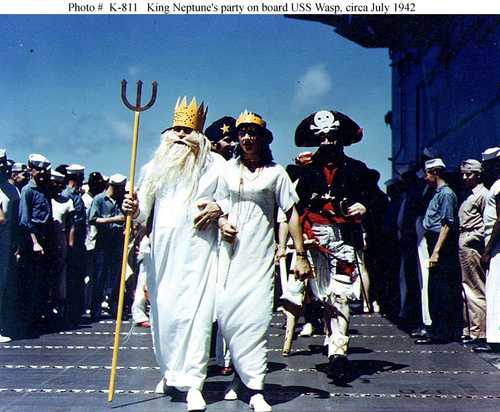
Wasp was manned by crusty Shellbacks by the time it reached Guadalcanal to support the amphibious assault on 7 August 1942.
A view of the new 40mm mount that was added to Wasp during her June 1942 yard visit. (below)Early in May 1942, almost simultaneously with Wasp's second Malta run—Operation Bowery—the Battle of the Coral Sea had been fought, then the Battle of Midway a month later. These battles reduced the U.S. to three carriers in the Pacific, and it became imperative to transfer Wasp.
Wasp was hurried back to the U.S. for alterations and repairs at the Norfolk Navy Yard.
You can see the workers busy installing the new gun platform where the ladder is.
Wasp in the yard at Norfolk from December 1941 through January 1942. (below)
She retained her quadruple 1.1"/75 battery but most of her 0.50 caliber machine guns were replaced by 20-mm guns and she received a CXAM-1 air-search radar. She had heavier eight 5" single-barrel open-mount guns with 4 on each end of the flight deck, but it is unlikely the would have been in anything other than local control in a hot war scenario.
The much smaller 1.1-inch "Chicago piano" mounts were near the island like the much larger 5" enclosed mounts were on the later carriers that would have been capable of being used fire a sophisticated radar fire control system. These pictures only highlight the weaknesses of the undersized design due to the treaty limitations in place when the ship was designed and built.
There was still time for Wasp to participate in normal activities while transiting to the South Pacific.During the carrier's stay in the Tidewater region, Captain Reeves – who had been promoted to flag rank – was relieved by Captain Forrest P. Sherman on 31 May. Departing Norfolk on 6 June, Wasp sailed with TF 37 which was built around the carrier and the battleship North Carolina and escorted by Quincy, San Juan and six destroyers. The group transited the Panama Canal on 10 June, at which time Wasp and her consorts became TF 18, the carrier flying the two-star flag of Rear Admiral Leigh Noyes.
Arriving at San Diego on 19 June, Wasp embarked the remainder of her complement of aircraft, Grumman TBF-1 Avengers and Douglas SBD-3 Dauntlesses, the latter replacing the old Vindicators. On 1 July, she sailed for the Tonga Islands as part of the convoy for the five transports carrying the 2nd Marine Regiment.
Commanding Officer, Capt. Forrest Sherman, inspects the Marines aboard Wasp in June 1942. (below)

Wasp conducts its "Crossing the Line" ceremony in July of 1942. (below)

Wasp was manned by crusty Shellbacks by the time it reached Guadalcanal to support the amphibious assault on 7 August 1942.
USS Wasp (CV-7) Part Five

Among those present are (from left to right, in the right center) Commander D.F. Smith (hatless); Captain Forrest P. Sherman, Commanding Officer (wearing helmet); Rear Admiral Leigh Noyes, Commander Task Group 61.1 (facing camera); and Lieutenant Commander Wallace M. Beakley, Commander Wasp Air Group, who is making his report to RADM Noyes.
Note SBD-3 Dauntless scout bombers (one with a rather small National star painted on its fuselage) on the flight deck and .30 caliber machine gun mounted on the bridge bulwark.
Grumman F4F-4 Wildcat fighters and Douglas SBD Dauntless dive bombers aboard Wasp in July–September 1942. (below)

USS Buchanan (DD-484) steaming near Wasp prior to refueling from her on 3 August 1942. (below)
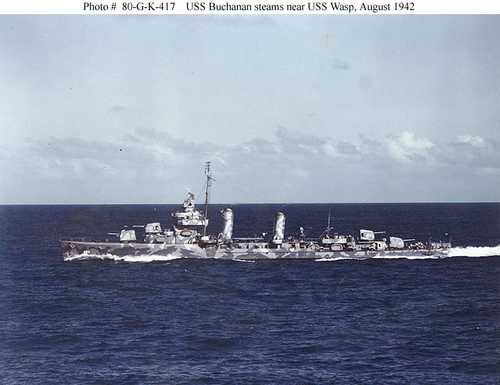
Buchanan refuels from Wasp on 3 August 1942. (below)
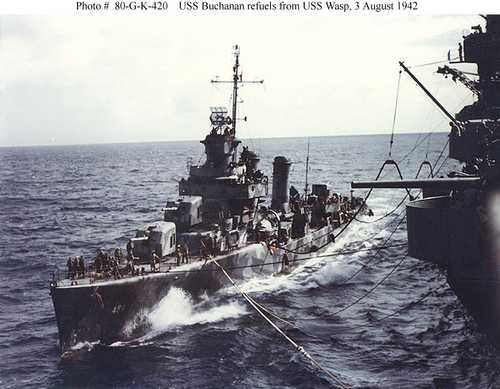
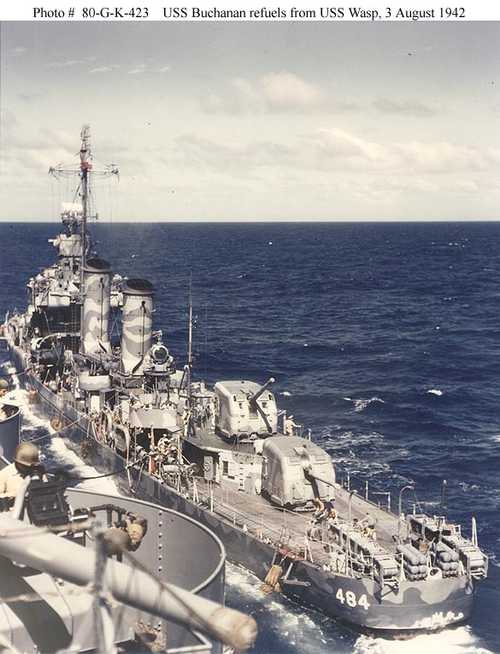
Scene on the carrier's port bridge wing during operations off Guadalcanal on 7 August 1942. (below)Wasp – together with the carriers Saratoga and Enterprise – was assigned to the Support Force under Vice Admiral Frank Jack Fletcher. Under the tactical command of Rear Admiral Noyes, embarked on Wasp, the carriers were to provide air support for the invasion and initiation of the Guadalcanal campaign.
Among those present are (from left to right, in the right center) Commander D.F. Smith (hatless); Captain Forrest P. Sherman, Commanding Officer (wearing helmet); Rear Admiral Leigh Noyes, Commander Task Group 61.1 (facing camera); and Lieutenant Commander Wallace M. Beakley, Commander Wasp Air Group, who is making his report to RADM Noyes.
Note SBD-3 Dauntless scout bombers (one with a rather small National star painted on its fuselage) on the flight deck and .30 caliber machine gun mounted on the bridge bulwark.
Grumman F4F-4 Wildcat fighters and Douglas SBD Dauntless dive bombers aboard Wasp in July–September 1942. (below)
USS Buchanan (DD-484) steaming near Wasp prior to refueling from her on 3 August 1942. (below)

Buchanan refuels from Wasp on 3 August 1942. (below)


Last edited by a moderator:
USS Wasp (CV-7) Part Six
_being_torpedoed_on_15_September_1942_(80-G-457818).jpg/1920px-USS_O'Brien_(DD-415)_being_torpedoed_on_15_September_1942_(80-G-457818).jpg)
Wasp in her death throes after being torpedoed. (below)
_burning_on_15_September_1942_(fsa.8e00768).jpg/1280px-USS_Wasp_(CV-7)_burning_on_15_September_1942_(fsa.8e00768).jpg)
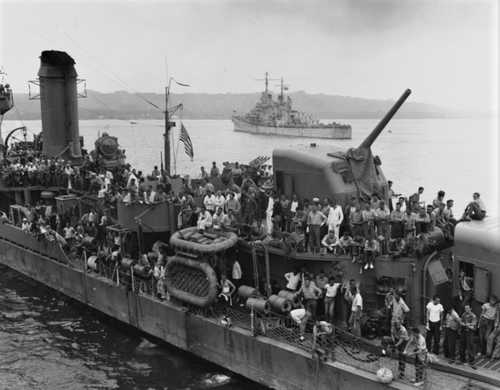
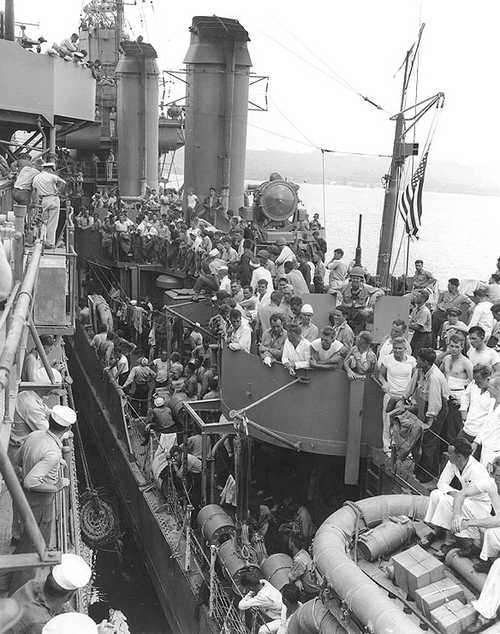
Laffey would be torpedoed and sunk with heavy loss of life in the Naval Battle of Guadalcanal on 13 November 1942. Her name would be given to DD-724 in 1943. DD-724 would barely survive a kamikaze attack in 1945, be repaired and continue to serve for many years later. She is currently on the display at Patriots Point.
https://en.wikipedia.org/wiki/USS_Laffey_(DD-724)
A torpedo from I-19 hits O’Brien. USS Wasp can be seen burning in the background. (below)On Tuesday, 15 September 1942, the carriers Wasp and Hornet and battleship North Carolina with 10 other warships were escorting the transports carrying the 7th Marine Regiment to Guadalcanal as reinforcements. Wasp was operating some 150 nautical miles (170 mi; 280 km) southeast of San Cristobal Island. Her aircraft were being refueled and rearmed for antisubmarine patrol missions and Wasp had been at general quarters from an hour before sunrise until the time when the morning search returned to the ship at 10:00. Thereafter, the ship was in condition 2, with the air department at flight quarters. The only contact with the Japanese that day had been a Japanese four-engined flying boat that was downed by one of Wasp's F4F Wildcats at 12:15.
About 14:20, the carrier turned into the wind to launch eight F4F Wildcats and 18 SBD Dauntlesses and to recover eight F4F Wildcats and three SBD Dauntlesses that had been airborne since before noon. Lt. (jg) Roland H. Kenton, USNR, flying a F4F-3 Wildcat of VF-71 was the last aircraft off the deck of Wasp. The ship rapidly completed the recovery of the 11 aircraft before turning to starboard, heeling slightly as she did so. At 14:44 a lookout reported "three torpedoes ... three points forward of the starboard beam".
A spread of six Type 95 torpedoes was fired at Wasp at about 14:44 from the tubes of the B1 Type submarine I-19. Wasp put over her rudder hard to starboard to avoid the salvo, but it was too late. Three torpedoes struck in quick succession about 14:45; one actually breached, left the water, and struck the ship slightly above the waterline. All hit in the vicinity of the ship's gasoline tanks and magazines.
Two of the spread of torpedoes passed ahead of Wasp and were observed passing astern of Helena before O'Brien was hit by one at 14:51 while maneuvering to avoid the other (structural damage from this torpedo hit would eventually lead to O'Brien's sinking a month later). The sixth torpedo passed either astern or under Wasp, narrowly missed Lansdowne in Wasp's screen about 14:48, was seen by Mustin in North Carolina's screen about 14:50, and struck North Carolina about 14:52.
_being_torpedoed_on_15_September_1942_(80-G-457818).jpg/1920px-USS_O'Brien_(DD-415)_being_torpedoed_on_15_September_1942_(80-G-457818).jpg)
https://en.wikipedia.org/wiki/USS_O'Brien_(DD-415)This explosion did little obvious damage, but it set up severe structural stresses throughout the framework of O'Brien. She was able to proceed under her own power, and on 16 September she reached Espiritu Santo, where the sailors from Curtiss made temporary repairs. O’Brien next steamed out on 21 September, bound for Noumea, New Caledonia, for further repairs by the repair ship Argonne. Then, she steamed out on 10 October, bound for San Francisco Bay.
O'Brien made it to Suva in Fiji on 13 October, and then steamed out once more on 16 October. The rate of leakage of seawater into O'Brien continued to increase, and on 18 October it was necessary for O’Brien to head for the nearest anchorage. Large amounts of topside weights were jettisoned, and preparations were made for abandoning the ship, but her captain still thought that she could be taken intact to Pago Pago.
However, at about 0600 on 19 October, her bottom suddenly split open considerably, and her forward and after hull portions began to work independently. At 0630, all hands except for a small salvage crew abandoned, but half an hour later O'Brien was abandoned entirely. Just before 0800 she descended beneath the waves, and after steaming nearly 3,000 nautical miles (5,600 km) since she had been torpedoed. All members of her crew were saved.
Wasp in her death throes after being torpedoed. (below)
_burning_on_15_September_1942_(fsa.8e00768).jpg/1280px-USS_Wasp_(CV-7)_burning_on_15_September_1942_(fsa.8e00768).jpg)
USS Laffey (DD-459) with surviving members of the crew of the sunken aircraft carrier USS Wasp (CV-7) on board. USS Juneau (CL-52) can be seen in the background. (below)After consulting with Rear Admiral Leigh Noyes, Captain Sherman ordered "abandon ship" at 15:20. All badly injured men were lowered into rafts or rubber boats. Many un-wounded men had to abandon ship from aft because the forward fires were burning with such intensity. The departure, as Sherman observed it, looked "orderly", and there was no panic. The only delays occurred when many men showed reluctance to leave until all the wounded had been taken off. The abandonment took nearly 40 minutes, and at 16:00 Sherman abandoned the ship once he was satisfied that no survivors were left on board.
Although the submarine hazard caused the accompanying destroyers to lie well clear or to shift position, they carried out rescue operations until Laffey, Lansdowne, Helena, and Salt Lake City had 1,946 men embarked. One hundred ninety-three men had died and 366 were wounded during the attack. All but one of her 26 airborne aircraft made a safe trip to carrier Hornet nearby before Wasp sank, but 45 aircraft went down with the ship. Another Japanese submarine, I-15, duly observed and reported the sinking of Wasp, as other US destroyers kept I-19 busy avoiding 80 depth charges. I-19 escaped safely.


Laffey would be torpedoed and sunk with heavy loss of life in the Naval Battle of Guadalcanal on 13 November 1942. Her name would be given to DD-724 in 1943. DD-724 would barely survive a kamikaze attack in 1945, be repaired and continue to serve for many years later. She is currently on the display at Patriots Point.
https://en.wikipedia.org/wiki/USS_Laffey_(DD-724)
Last edited by a moderator:
SPAD S.VII


Alan Kulwicki



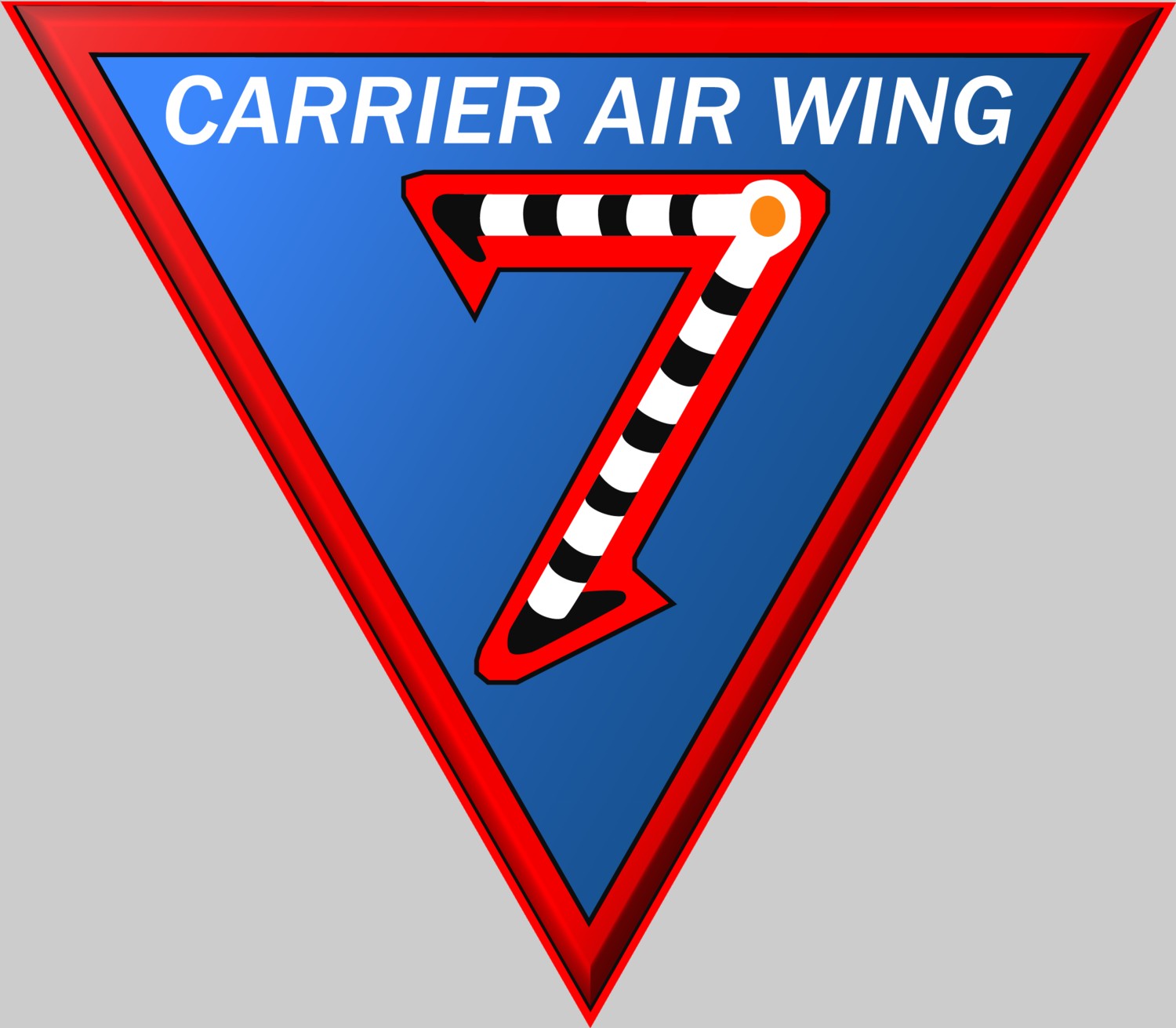
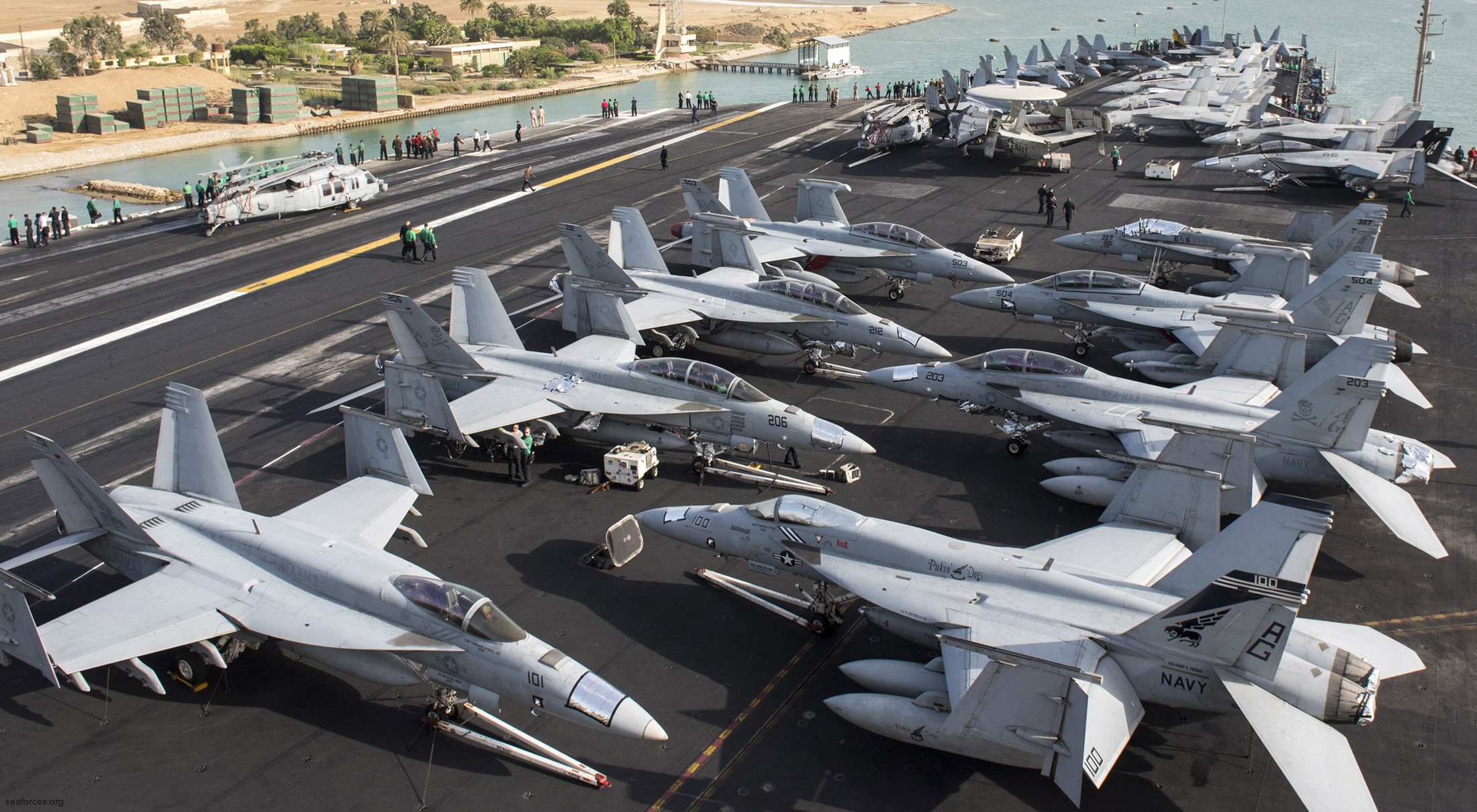
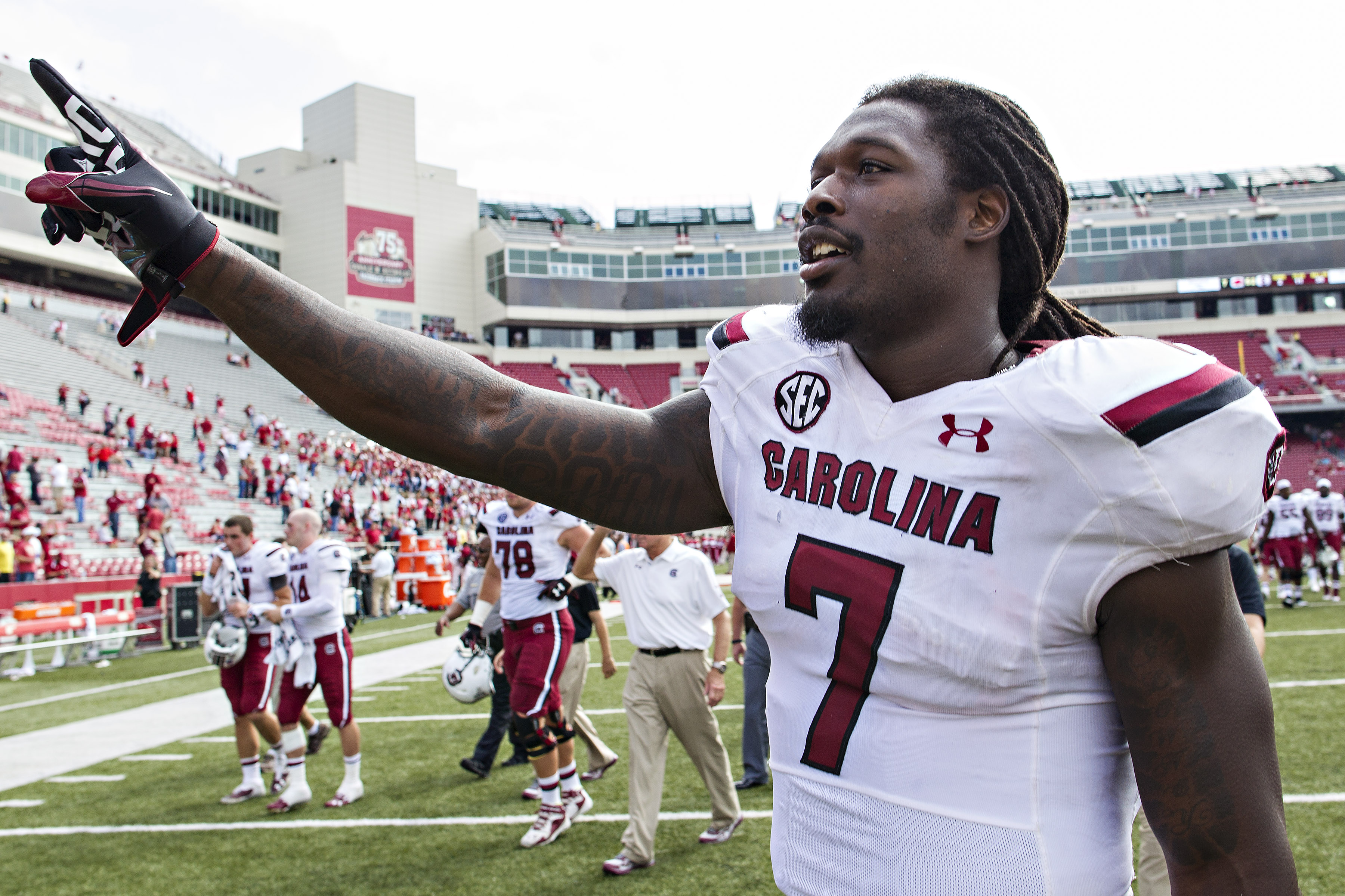


:format(jpeg)/cdn.vox-cdn.com/uploads/chorus_image/image/35742900/20131123_jla_ay3_164.0.jpg)



/cdn.vox-cdn.com/photo_images/3992098/124551691.jpg)
